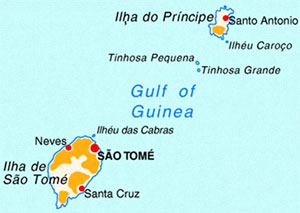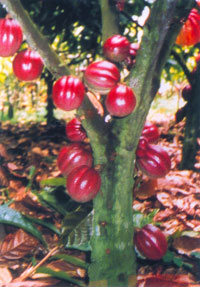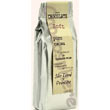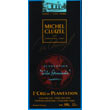 FLAVOR PROFILE: Earthen; predominantly simple cocoa, tart red fruit, wood & spices (cinnamon / clove); structure generally flattens out toward finish
FLAVOR PROFILE: Earthen; predominantly simple cocoa, tart red fruit, wood & spices (cinnamon / clove); structure generally flattens out toward finish
CHARACTERISTICS: acrid & acidic; subtle bitterness; sometimes aggressive
Neighboring islands in the Gulf of Guinea off the west coast of Africa where the continent bends along the prime meridian before dropping due south. The varietal called Cacáo Monka by its proprietor on the smaller, more northern island – Príncipe – could be the descendent of the 1st cacáo successfully harvested in the Old World – 30 plants (in all likelihood transplants of a transplant) brought from Espirito Santo, Brazil in 1822, coinciding with Brazil’s independence when conflicts & disputes forced Portuguese colonists to sail back across the Atlantic, fleeing with cacáo to Príncipe, a Portuguese possession.
Indeed, the King João VI of Portugal, anticipating the collapse of his New World holdings in Brazil, issued a royal decree in 1819 to spirit small cacáo trees from there to his territories off the coast of Africa. Along with them, the Portuguese also transplanted their pioneering methods of efficient cocoa production, viz., all the plantation drudgery that would eventuate just these 2 small islands becoming the world capital of cocoa in the early 20th century.
Around 1850, cultivation spread to the bigger São Tomé, a once deserted island turned slave colony on account of the sugar industry where upwards of 100,000 Africans, many from the Kongo Kingdom, toiled in the fields & refineries. Incredibly de facto slavery lasted until it gained independence in 1975, in defiance of official abolition over a century earlier. The sickening tricks of the trade involved a hellish matrix of Africans capturing then deporting inland enemies &/or criminals off the mainland into the hands of eager Portuguese who received them as ‘convict laborers’; or the colonists offering multi-year indentured contracts at the lowest wage that few could escape out from under due to debt incurred during their service, hence the term given to these people — serviçais; & outright fees for chattel in the face of anti-slavery laws which amounted to bribes / kickbacks from Portuguese brokers to their compatriot bureaucrats running the administration of the territory. The entire scandalous apparatus put the load squarely on the shoulder of the serviçais who did everything in the steaming roças (re: cocoa fields) of the tropics from picking pods, often carrying them on their backs to a central location for splitting open, scooping out their seeds, fermenting, drying, packing… on & on & on…. About the only consolation for this compulsory employment were living conditions & amenities arguably superior to what they left behind in Angola, Mozambique.
Both São Tomé & Príncipe probably still possess close copies of the original cacáo tree – possibly related to the Comum variety – thanks to inbreeding, allowing a taste of some direct history grown in their volcanic clay soils. Together these two islands formed the basis for most production in Africa today, providing a crucial link to the mainland for what’s known as West African Amelonado (a glorified Amazon in the shape of a round melon) as well as significant parts of Oceania. More seedlings eventually came to Príncipe in the 1950s from an unknown source, & to São Tomé from Ecuador (confirmed by sketches of Chalot in 1901), Trinidad, & Venezuela, among them some definite red-fruited Criollo reported by William Johnson in 1912, spurring a wide range of variability likened to Trinidad’s, including one type of exceptional quality, planted in an isolated area that displays clearly unique characteristics.
So contrary to popular opinion, it’s possible to discern pedigree in African chocolate, especially from São Tomé.







